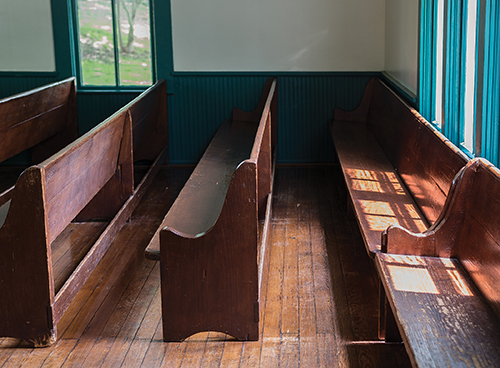10 surprising church giving facts
Tithe.ly collected church giving data from 2,000 churches in the past 24 months and put together a comprehensive list of both trends and misconceptions about giving.
Fact #1: The summer slump is a myth. The “Summer Slump” is based on the theory that people must be in-person to give. However, with a digital giving tool, giving can actually increase throughout the summer.
Fact #2: Big giving isn’t reserved for payday or end of month. The first, 15th and last day of the month are considered relatively big giving days, but the 5th, 12th, 19th and 26th also are elevated days of giving.
Fact #3: Sunday isn’t the only day of the week people like to give. The biggest single day of giving is Sunday; however, 67% of giving happens on all other days. People manage their money on their own schedules, while also aligning their “spend” based on when they get paid.
Fact #4: People give at all times of the day and night. More than 30% of giving comes between 9 p.m. and 6 a.m., the late and early morning hours. This may be a time when donors are watching sermons or reading the Bible and may be inspired to give.
Fact #5: Mobile giving is the clear leader, but people like options. At 57%, mobile giving is the preferred way of giving digitally. Web/online giving accounts for 24% with text giving at 14%, 4% through administrative activities and 0.37% via kiosk. Combining all forms of mobile/web giving greatly increases the options people use to give.
Fact #6: People are not afraid to give big on their mobile phone. Big gifts are not limited to checks as a preferred means of delivering funds – more than 50% of gifts processed digitally were more than $250.
Fact #7: Promoting recurring giving leads to great results. “Recurring giving” happens digitally if someone sets up an auto-pay gift that happens regularly. This is a strategy to grow giving with consistent givers – 13% of gifts were given through using recurring giving.
Fact #8: Consistent givers show amazing generosity. Consistent givers account for 15% of the population but 51% of total dollar giving. Eighty-five percent of givers are occasional, and make up less than 50% of total giving.
Fact #9: Card-based giving is the preferred method for most. Just 3% of donors use bank account information, and 97% prefer using a card. This could be attributed to security and/or card rewards.
Fact #10: Visa leads the way, but support for all brands is important. Most people give using a Visa or Mastercard, but offering AMEX and Discover is important as well.
Providing as many options as possible when it comes to cards, mobile app, text and web is the recurring theme.
Church attendance trends
Barna recently conducted a study examining church attendance in the U.S. The report ranked large cities on attendance using three metrics: churched (very active), unchurched and dechurched. The churched designation includes those who have been to church in the past week – excluding special events such as a wedding — while unchurched represents those who have not attended a service in the past six months – also excluding special events. Dechurched classifies people who used to be active churchgoers, whether very active, somewhat active or minimally active, but they have not attended church in the past six months (excluding special events). The surveys were conducted via telephone and online to a random sample of 76,505 adults. The information was collected over a seven-year period.

Overall, 38% of Americans were active churchgoers, 43% of people were unchurched, and 34% are dechurched. The most churched cities in America are: Chattanooga, TN (59%); Salt Lake City, UT (59%); Augusta / Aiken, GA (57%); Baton Rouge, LA (57%); and Birmingham / Anniston / Tuscaloosa, AL (56%). The most unchurched cities are: San Francisco / Oakland / San Jose, CA (60%); Reno, NV (59%); Springfield / Holyoke, MA (57%); Boston / Manchester, MA (56%); and Las Vegas, NV (55%). San Francisco / Oakland / San Jose, CA (47%) topped the list of the highest dechurched cities, with the remaining four as follows: Boston / Manchester, MA (46%); Seattle / Tacoma, WA (45%); Portland / Auburn, ME (45%) and Springfield / Holyoke, MA (43%).
Christian Growth Index Annual Report
The Christian Digital Research Group recently released a brief of the Christian Growth Index Annual Report. The index, created in 2009 by Global Media Outreach, tracks believers starting three months after they decide to follow Jesus. It is intended to track spiritual growth, and if daily activities were affected by their decision. In the 2016 survey, 295,136 new and recommitting believers were contacted via email after they visited a Gospel Presentation by Global Media Outreach and provided their contact information. Most (23, 966) people responded, in various languages.
In their studies, Global Media Group has chosen to focus on six areas as possible indicators of someone following Jesus: Assurance – Does the new believer understand the decision they made and are certain they believe and accept Jesus as their Savior; World View – Are the new believer’s thoughts and actions shaped by God’s Spirit – do they turn to God for help with decisions; Scripture Engagement – Is the new believer reading or listening to the Bible and how often; Worship – Is the new believer engaged in Church community and worshipping in community; Prayer – Is the new believer talking to God and how often; Sharing Faith with others – Has the new believer shared their faith with others and how often.
The results of the index are as follows: 86% are very certain of knowing Christ; 59.2% attend church on a weekly basis; 78.7% have daily thoughts/changes in actions; 54.4% spend more than 10 minutes in prayer; 75.1% read the Bible at least once a week; and 91.3% have shared their faith. International responses showed that 59% of respondents attend church weekly, 75% report reading their Bibles weekly or daily, and 91% said they have shared their faith at least once.
Financial motivations of Christians
The Generosity Gap, a Barna report produced along with Thrivent Financial, studied the drivers of Christian giving and generosity. Overall, half of Christians think of others when identifying a financial goal for life. However, one-third of Christians are self-focused with their financial priorities. The report divided people in to two groups: Givers, who are motivated by “others-focused goals” such as providing for family (43%), giving charitably (23%), serving God with their money (20%), or leaving a legacy for others (14%); and Keepers, those motivated by “self-focused” goals, such as supporting the lifestyle they want (42%), to be content (37%), to be debt-free (16%), or earning enough to show they work hard (5%).
 The study categorized age groups as Elders, Boomers, Gen-Xers and Millennials. Overall, 55% of Elders are Givers, with 25% being Keepers. Boomers are 50% Givers and 33% Keepers, Gen-Xers are 46% Givers and 37% Keepers, and Millennials are 56% Givers and 35% Keepers. The goal of “providing for a family” was a main goal for Millennials (31%) compared to 18% Gen-Xers and Boomers, with 13%. This helped to push them more towards Givers. Elders were also a higher percentage of Givers, having a higher percentage goal of “serving God with their money” at 19%.
The study categorized age groups as Elders, Boomers, Gen-Xers and Millennials. Overall, 55% of Elders are Givers, with 25% being Keepers. Boomers are 50% Givers and 33% Keepers, Gen-Xers are 46% Givers and 37% Keepers, and Millennials are 56% Givers and 35% Keepers. The goal of “providing for a family” was a main goal for Millennials (31%) compared to 18% Gen-Xers and Boomers, with 13%. This helped to push them more towards Givers. Elders were also a higher percentage of Givers, having a higher percentage goal of “serving God with their money” at 19%.
Keepers, at 45%, earn more than $75,000 a year, while 39% of Givers earned that amount. This shows that Givers aren’t necessarily giving due to more income. However, Keepers were more likely to live in a city, with higher costs (37% vs. 30% of Givers). Givers are married at a higher rate (65%) than Keepers (51%), and also have children under 18 living at home at a higher percentage (47% to 41% Keepers).
Thirty-three percent of Givers donated $500 or more in the past year to either a church or nonprofit, vs. 22% of Keepers. Keepers also were more likely to donate $2,500 or more (14% for Keepers vs. 8% for Givers), and give 10% or more of income (25% vs. 13%). 42% believe that every member [of their church] should give some amount. Thirty percent of Keepers believe this. They also believe at a higher rate that Christians should give their church 10% of their income (30% vs. 22%).
Keepers tend to associate generosity with emotional or relational support (37% vs. 24% of Givers), and Givers believe serving, at 36% (vs. Keeper’s 27%), is what they associate with generosity.
Bible-minded cities

Barna, with the American Bible Society, conducted a study that focused on Americans’ interactions with the Bible – and how it varies from region to region. The study was based on interviews with 76,505 adults over a 10-year period. Barna and the American Bible Society rank the top media markets in the U.S. based on level of Bible engagement. The term “Bible-minded” is identified as those who have read the Bible within the past week and who believe strongly believe it is accurate in its teachings.

In 2017, Chattanooga, TN is the top Bible-minded city in America, at 50%. Chattanooga also held this position in the 2015 survey. Birmingham / Anniston / Tuscaloosa, AL is the runner-up city, at 49%. Roanoke / Lynchburg, VA came in third at 38%, with the fourth spot held by the Tri-Cities area of Alabama at 48%. Shreveport, LA (47%) came in fifth, and the following ranked in order of: Charlotte, NC: (46%); Springfield, MO (46%); Little Rock / Pine Bluff, AR (44%); Knoxville, TN (44%); and Greenville / Spartanburg / Anderson, SC / Asheville, NC (44%). As for the least Bible-minded cities, the No. 1 city for the second year in a row was Albany / Schenectady / Troy, NY at 10%. Boston, MA / Manchester, NH are in second at 11%, and Providence, RI / New Bedford, MA is in third at 12%. For fourth place and beyond, the order was as follows: Las Vegas, NV (14%); San Francisco / Oakland / San Jose, CA (15%); Hartford / New Haven, CT (16%); Salt Lake City, UT (17%); and New York, NY (17%).
Daily life of religious Americans
Pew Research Center conducted a study focusing on religion in the everyday life of Americans, as a part of its ongoing U.S. Religious Landscape Study.
 Overall findings showed that those who are highly religious (identified by attending religious services once a week and praying every day) are more likely to volunteer and are more involved with their communities. They are also more engaged with extended family. These Americans were also happier with the general state of their lives, with 40% stating they were “very happy,” compared to 29% of less religious adults stating they were very happy. Forty-seven percent of highly religious Americans saw extended family once or twice a month, compared to the less religious (30%) who said they see extended family at least once a month. Sixty-five percent of highly religious adults donated time or money to the poor within the past week, compared to 41% of less religious adults.
Overall findings showed that those who are highly religious (identified by attending religious services once a week and praying every day) are more likely to volunteer and are more involved with their communities. They are also more engaged with extended family. These Americans were also happier with the general state of their lives, with 40% stating they were “very happy,” compared to 29% of less religious adults stating they were very happy. Forty-seven percent of highly religious Americans saw extended family once or twice a month, compared to the less religious (30%) who said they see extended family at least once a month. Sixty-five percent of highly religious adults donated time or money to the poor within the past week, compared to 41% of less religious adults.
Beyond these findings, both the highly religious and less religious responded similarly in regards to health, social consciousness and interpersonal interactions. Forty-three percent of the less religious group say they lost their temper in the past week, compared to 41% of the highly religious group. Thirty-nine percent of the highly religious stated they had told a white lie within the week, compared to 45% of the not highly religious. Percentages were nearly the same when asked if they had overeaten that week (58% for both), or exercised at least three times in the week (43% for the not highly religious, 44% for the highly religious). When asked if they recycled, 47% of the highly religious stated they did, while 46% of the not highly religious stated they participated in recycling. When purchasing goods, 26% of highly religious people and 27% of not highly religious people considered the company’s environmental record. Twenty-six percent of the not highly religious and 28% of the highly religious considered employee wages in purchasing decisions.


